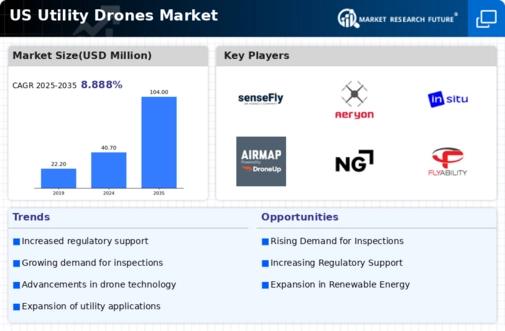The US Utility Drones Market has seen significant growth in recent years, driven by advancements in drone technology and increasing demand for efficient monitoring, maintenance, and inspection solutions across various utility sectors. This competitive landscape is characterized by a diverse range of players vying for market share, each bringing unique capabilities, strengths, and innovative offerings to the table. As utilities seek to enhance operational efficiency, reduce costs, and improve safety in their operations, companies must strategically position themselves by leveraging cutting-edge technologies while addressing specific regulatory and environmental challenges.
The market's expansion presents opportunities for both established firms and new entrants to capitalize on changing industry trends and customer needs, making competitive intelligence critical for driving long-term success in this dynamic sector.senseFly has established a strong foothold in the US Utility Drones Market by offering advanced drone solutions tailored for utility applications. Known for its robust mapping and surveying capabilities, senseFly's products effectively assist utility companies in efficient grid inspections, vegetation management, and asset monitoring.
The company's strengths lie in its user-friendly software integration, high-quality imagery, and real-time data collection, which empower utilities to make informed decisions and enhance operational workflows.
The presence of senseFly in the US market is bolstered by its commitment to customer service and support, ensuring that utility operators can maximize the benefits of drone technology in their operations. senseFly continues to innovate and adapt to the evolving needs of its clients, solidifying its competitive advantage in the market.Aeryon Labs is another key player in the US Utility Drones Market, recognized for its impressive capabilities in aerial surveillance and inspection services specifically designed for utilities.
Aeryon Labs specializes in providing drones that are equipped with high-resolution imaging systems, thermal sensors, and integrated software solutions for comprehensive data analysis and reporting. Their products are widely used for infrastructure inspection, mapping, and situational awareness, making them a go-to choice for utility operators seeking accuracy and efficiency. Aeryon Labs has gained market presence through strategic partnerships and mergers, enabling it to enhance its service offerings and technology portfolio. The company's strengths revolve around its innovation-driven approach and a focus on meeting the stringent requirements of utility companies, ensuring reliability and compliance in critical operations.
Aeryon Labs continues to expand its footprint in the US, reinforcing its position as a leader in the utility drone sector.























